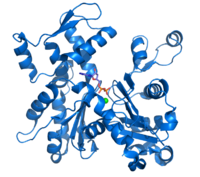
Photo from wikipedia
A fundamental challenge in cell biology is to understand how cells generate actomyosin‐based contractile force. Here we study the actomyosin contractile ring that divides cells during cytokinesis and generates tension… Click to show full abstract
A fundamental challenge in cell biology is to understand how cells generate actomyosin‐based contractile force. Here we study the actomyosin contractile ring that divides cells during cytokinesis and generates tension by a mechanism that remains poorly understood. Long ago a muscle‐like sliding filament mechanism was proposed, but evidence for sarcomeric organization in contractile rings is lacking. We develop a coarse‐grained model of the fission yeast cytokinetic ring, incorporating the two myosin‐II isoforms Myo2 and Myp2 and severely constrained by experimental data. The model predicts that ring tension is indeed generated by a sliding filament mechanism, but a spatially and temporally homogeneous version of that in muscle. In this mechanism all pairs of oppositely oriented actin filaments are rendered tense as they are pulled toward one another and slide through clusters of myosin‐II. The mechanism relies on anchoring of actin filament barbed ends to the plasma membrane, which resists lateral motion and enables filaments to become tense when pulled by myosin‐II. A second fixed filament component is independent of lateral anchoring, generated by chains of like‐oriented actin filaments. Myo2 contributes to both components, while Myp2 contributes to the sliding filament component only. In the face of instabilities inherent to actomyosin contractility, organizational homeostasis is maintained by rapid turnover of Myo2 and Myp2, and by drag forces that resist lateral motion of actin, Myo2 and Myp2. Thus, sliding and fixed filament mechanisms contribute to tension in the disordered contractile ring without the need for the sarcomeric architecture of muscle.
Journal Title: Cytoskeleton
Year Published: 2019
Link to full text (if available)
Share on Social Media: Sign Up to like & get
recommendations!